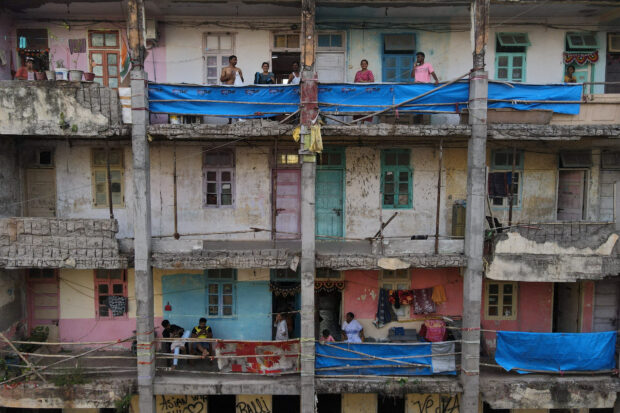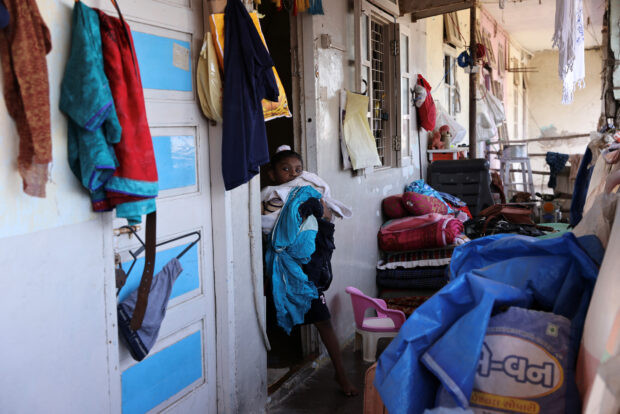Some Mumbai residents risk safety for affordable, central housing

Residents stand in the corridors outside their homes at the Worli dairy quarters building in Mumbai, India, August 2, 2023. This building complex, situated amid luxury towers and expansive villas of Mumbai’s most exclusive postcode, exemplifies the price some middle-class employees are willing to pay for a home in one of the world’s most expensive property markets. “It’s dangerous, especially with parents and children,” added resident Sumit Shinde. “But it’s not possible for me, or any middle class family, to purchase a new home in Mumbai. It’s very expensive.” REUTERS/Francis Mascarenhas
Amid the luxury towers and expansive villas of Mumbai’s most exclusive postcode, a crumbling apartment block exemplifies the risks some people are willing to take to live in one of the world’s most expensive property markets.
Some 600 people, mainly middle-class civil servants and their families, live in the government-owned, dilapidated block, located across the Arabian Sea in the same Worli neighbourhood where the daughter of India’s richest man Mukesh Ambani lives.
Children play outside their units along corridors with rusted, broken railings held together with rags and the steel bars reinforcing the structure are visible from where the cement has fallen off the floors and ceilings.
“Anything can fall here, especially during the monsoon,” said Anil Aiwale, a government employee who has been living in the block with his family for the past five years. “The lack of affordable living options causes people to continue to live in high risk structures.”
Mumbai, capital of Maharashtra state, is India’s most populous city, and the nation’s most expensive place to buy residential property, according to data from Anarock Research.
Article continues after this advertisementPrices for prime property, such as that in Worli, saw the sixth fastest year-on-year growth globally in the first quarter of this year, a survey by international property consultants Knight Frank shows, just behind global financial hub Singapore and ahead of China’s financial capital Shanghai.
Article continues after this advertisement
Mayank, Rahul Makwana’s nephew, helps his family move from the fourth to the first floor after receiving notice of the building pillars weakening, at the Worli dairy quarters building in Mumbai, India, March 30, 2023.The building faces the sea, making the structure very vulnerable during monsoon season and the walls and doors of many units waterlogged and mouldy. The crumbling structure, which houses more than 600 people, has been categorised by local authorities as grade 1 dilapidated building and could collapse during the city’s heavy monsoon season. “I was the only one living on the 4th floor in this wing of the building,” said Makwana. “The government had asked me to move out because they plan to demolish the entire floor because the pillars of the building can’t take the weight anymore.” REUTERS/Francis Mascarenhas
Some families living in the Worli block, which is particularly vulnerable to the monsoon rains that lash Mumbai from June to September every year, say these statistics reinforce their determination to stay put, despite the risks.
Because the block faces the sea, the walls and doors of many units are waterlogged and mouldy. Resident Rahul Makwana, who moved to a lower floor, said the entire fourth floor was going to be demolished because of structural issues.
“It’s dangerous, especially with parents and children,” added resident Sumit Shinde. “But it’s not possible for me, or any middle class family, to purchase a new home in Mumbai. It’s very expensive.”
Depending on their unit’s size, residents pay between 8,000 and 13,000 rupees ($97-$158) a month in rent to the state government. That rent would cover a property on the fringes of the city, but not anything more than a unit in a slum near Worli.
A state government official, who declined to be named because they were not authorised to speak to the media, said the bloc’s residents had not been served an eviction notice, but the state has offered them alternative accommodation in the suburbs.
Several residents, however, said transport to and from their offices in Worli would cost too much and take too long.
“The location of this building is great, it’s very convenient for me to go to work,” resident Aiwale said. “Affordable housing is impossible to find in a city like Mumbai.”